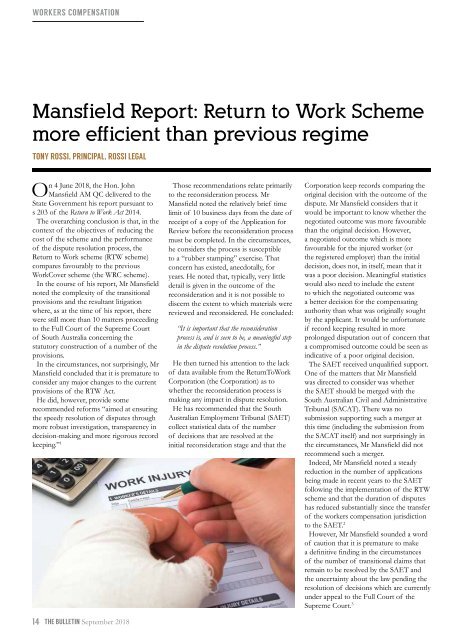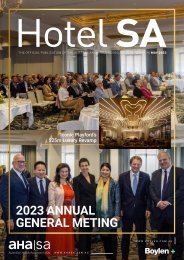LSB September 2018_Web
You also want an ePaper? Increase the reach of your titles
YUMPU automatically turns print PDFs into web optimized ePapers that Google loves.
WORKERS COMPENSATION<br />
Mansfield Report: Return to Work Scheme<br />
more efficient than previous regime<br />
TONY ROSSI, PRINCIPAL, ROSSI LEGAL<br />
On 4 June <strong>2018</strong>, the Hon. John<br />
Mansfield AM QC delivered to the<br />
State Government his report pursuant to<br />
s 203 of the Return to Work Act 2014.<br />
The overarching conclusion is that, in the<br />
context of the objectives of reducing the<br />
cost of the scheme and the performance<br />
of the dispute resolution process, the<br />
Return to Work scheme (RTW scheme)<br />
compares favourably to the previous<br />
WorkCover scheme (the WRC scheme).<br />
In the course of his report, Mr Mansfield<br />
noted the complexity of the transitional<br />
provisions and the resultant litigation<br />
where, as at the time of his report, there<br />
were still more than 10 matters proceeding<br />
to the Full Court of the Supreme Court<br />
of South Australia concerning the<br />
statutory construction of a number of the<br />
provisions.<br />
In the circumstances, not surprisingly, Mr<br />
Mansfield concluded that it is premature to<br />
consider any major changes to the current<br />
provisions of the RTW Act.<br />
He did, however, provide some<br />
recommended reforms “aimed at ensuring<br />
the speedy resolution of disputes through<br />
more robust investigation, transparency in<br />
decision-making and more rigorous record<br />
keeping.” 1<br />
Those recommendations relate primarily<br />
to the reconsideration process. Mr<br />
Mansfield noted the relatively brief time<br />
limit of 10 business days from the date of<br />
receipt of a copy of the Application for<br />
Review before the reconsideration process<br />
must be completed. In the circumstances,<br />
he considers the process is susceptible<br />
to a “rubber stamping” exercise. That<br />
concern has existed, anecdotally, for<br />
years. He noted that, typically, very little<br />
detail is given in the outcome of the<br />
reconsideration and it is not possible to<br />
discern the extent to which materials were<br />
reviewed and reconsidered. He concluded:<br />
“It is important that the reconsideration<br />
process is, and is seen to be, a meaningful step<br />
in the dispute resolution process.”<br />
He then turned his attention to the lack<br />
of data available from the ReturnToWork<br />
Corporation (the Corporation) as to<br />
whether the reconsideration process is<br />
making any impact in dispute resolution.<br />
He has recommended that the South<br />
Australian Employment Tribunal (SAET)<br />
collect statistical data of the number<br />
of decisions that are resolved at the<br />
initial reconsideration stage and that the<br />
Corporation keep records comparing the<br />
original decision with the outcome of the<br />
dispute. Mr Mansfield considers that it<br />
would be important to know whether the<br />
negotiated outcome was more favourable<br />
than the original decision. However,<br />
a negotiated outcome which is more<br />
favourable for the injured worker (or<br />
the registered employer) than the initial<br />
decision, does not, in itself, mean that it<br />
was a poor decision. Meaningful statistics<br />
would also need to include the extent<br />
to which the negotiated outcome was<br />
a better decision for the compensating<br />
authority than what was originally sought<br />
by the applicant. It would be unfortunate<br />
if record keeping resulted in more<br />
prolonged disputation out of concern that<br />
a compromised outcome could be seen as<br />
indicative of a poor original decision.<br />
The SAET received unqualified support.<br />
One of the matters that Mr Mansfield<br />
was directed to consider was whether<br />
the SAET should be merged with the<br />
South Australian Civil and Administrative<br />
Tribunal (SACAT). There was no<br />
submission supporting such a merger at<br />
this time (including the submission from<br />
the SACAT itself) and not surprisingly in<br />
the circumstances, Mr Mansfield did not<br />
recommend such a merger.<br />
Indeed, Mr Mansfield noted a steady<br />
reduction in the number of applications<br />
being made in recent years to the SAET<br />
following the implementation of the RTW<br />
scheme and that the duration of disputes<br />
has reduced substantially since the transfer<br />
of the workers compensation jurisdiction<br />
to the SAET. 2<br />
However, Mr Mansfield sounded a word<br />
of caution that it is premature to make<br />
a definitive finding in the circumstances<br />
of the number of transitional claims that<br />
remain to be resolved by the SAET and<br />
the uncertainty about the law pending the<br />
resolution of decisions which are currently<br />
under appeal to the Full Court of the<br />
Supreme Court. 3<br />
14<br />
THE BULLETIN <strong>September</strong> <strong>2018</strong>


















